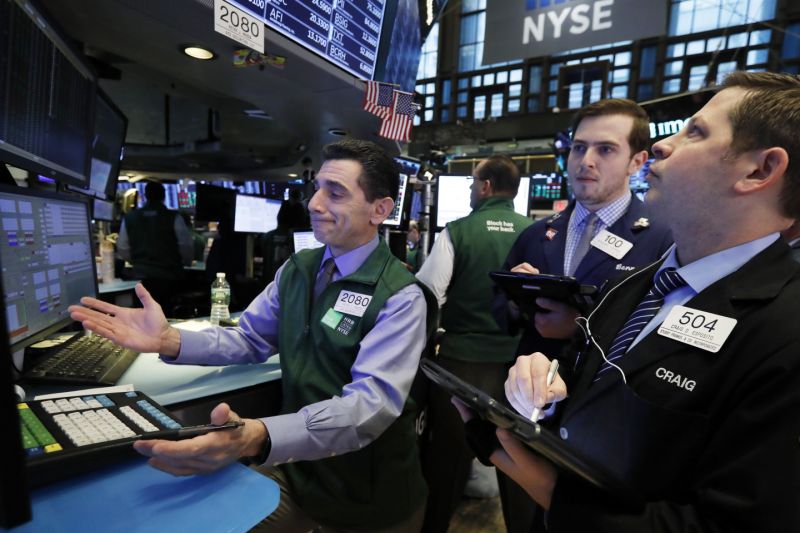
U.S. stocks gained after Federal Reserve officials announced they would keep benchmark interest rates unchanged and signaled flexibility in their policy normalization path forward.
The S&P 500 (^GSPC) rose 1.55%, or 41.05 points, as of market close. The Dow (^DJI) advanced 1.77%, or 434.9 points, having been up about 250 points just ahead of the release of the Federal Reserve’s latest policy statement at 2 p.m. ET. The Nasdaq (^IXIC) increased 2.17%, or 152.28 points.
The Federal Open Market Committee released a statement announcing it is pausing on interest rate hikes and holding the target range of its benchmark interest rates at the current band of 2.25% to 2.5% following its January meeting. This outcome had been widely expected by market participants.
Investors were watching closely for more clarity surrounding the Fed’s recent rhetoric of being “patient” with monetary policy amid incoming economic data and concerns of a global slowdown. To that end, the Fed delivered, saying in the statement, “In light of global economic and financial developments and muted inflation pressures, the Committee will be patient as it determines what future adjustments to the target range for the federal funds rate may be appropriate to support these outcomes.”
Fed officials also delivered additional information on the topic of balance sheet normalization. As of the December policy decision, the Fed had been allowing $50 billion in Treasuries and mortgage-backed securities to run off without reinvestment to try and shrink its balance sheet. However, the Fed said in a new statement Wednesday that it “is prepared to adjust any of the details for completing balance sheet normalization in light of economic and financial conditions.”
The Federal Reserve also removed reference to “some further gradual increases” in the Fed funds rate, which had been mentioned in the previous December statement.
Meanwhile, Tuesday after-the-bell, Apple executives won over investors with a narrative of a product and services ecosystem beyond the iPhone, offsetting concerns of declining flagship smartphone revenues and lagging sales in China. The company’s quarterly report sent Apple higher, in turn pulling the Dow – for which any $1 move in Apple shares results in an about 6.8-point move in the index – higher as well.
Likewise, Boeing during early trading Wednesday reported year-end results that beat Wall Street’s expectations on both the top and bottom lines and posted a strong fiscal 2019 forecast, helping to add to the Dow’s early gains.
As of Wednesday morning, 37.8% of the S&P 500’s market capitalization had reported fourth quarter results. Earnings have beaten by 2%, with 66% of companies exceeding their bottom-line estimates, Jonathan Golub, Credit Suisse chief U.S. equity strategist, wrote in an email. This compares to 4.8% and 70%, respectively, over the past three years.
The meeting “will present several delicate communication issues for the Fed. The net result, we believe, will be to further distance their communications from that put out after the December meeting, in terms of both rate hikes and balance sheet,” analysts from JPMorgan wrote in a note ahead of the meeting. “At the same time, we think they will try to avoid giving the impression that pause equals stop (or even cut) or that the economic outlook has materially downshifted.”
ECONOMY: Private sector employment increased more-than-expected in January, according to ADP
U.S. private sector employment increased by a better-than-expected 213,000 jobs in January, according to a report Wednesday from ADP Research Institute. Consensus expectations had called for an increase of 181,000 jobs, according to Bloomberg data. Last month, the private sector added a downwardly revised 263,000 positions.
“The labor market has continued its pattern of strong growth with little sign of a slowdown in sight,” Ahu Yildirmaz, vice president and co-head of the ADP Research Institute, said in a statement. “We saw significant growth in nearly all industries, with manufacturing adding the most jobs in more than four years. Midsized businesses continue to lead job creation, however the share of jobs was spread a bit more evenly across all company sizes this month.”
On Friday, the Bureau of Labor Statistics will release its monthly jobs report, with consensus estimates calling for 175,000 new private payrolls and 165,000 new total non-farm payrolls. This follows a surge of 312,000 new non-farm payrolls in December.
Pending sales for previously owned homes declined in December, according to the National Association of Realtors’ Wednesday report, providing the latest sign of softness in the housing market. The pending home index declined 2.2% month-over-month to a reading of 99, following a downwardly revised 0.9% decrease in November. Consensus expectations had been for the index to increase 0.5% on the month in December.
Meanwhile, existing-home sales fell 6.4% in December to the lowest level in three years, following two consecutive months of increases. Lawrence Yun, NAR’s chief economist, said housing sales were impacted by higher interest rates during much of 2018.
“Now, with mortgage rates lower, some revival in home sales is expected going into spring,” Yun said in a statement.




























